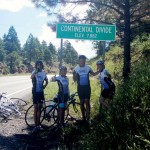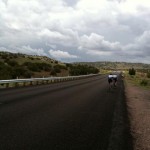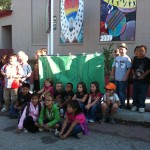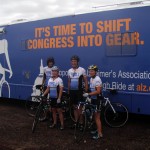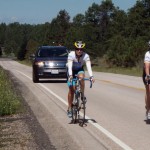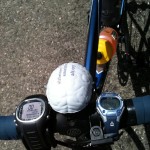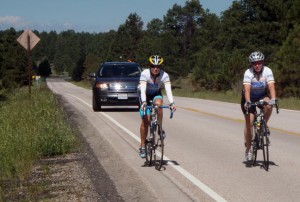
Editor’s note: This story was submitted by Jeff Harrison. If you would like to submit a story, email me at tucsonvelo@gmail.com.
Two University of Arizona scientists are among nearly five dozen Alzheimer’s researchers from across the country taking part in a cross-country bicycle ride to promote increased research funding for Alzheimer’s disease.
The Alzheimer’s Breakthrough Ride began July 17 in San Francisco. It ends on Sept. 21, World Alzheimer’s Day, when most of the 57 scientists in the event will pedal up to the U.S. Capitol to deliver petitions asking Congress to support legislation aimed at overcoming the disease. Alzheimer’s is a progressive neurological condition that causes significant memory loss. It is fatal and there is no known cure.
Lee Ryan, an associate professor of psychology at the UA, and Catherine Wasmann, a researcher in the School of Plant Sciences, covered the leg from Holbrook in northeastern Arizona to Albuquerque. Starting Aug. 1, Ryan and Wasmann rode more than 280 miles over desert plateau and pine forests, finishing in Albuquerque on Aug. 4.
Ryan, director of the of the UA Cognition and Neuroimaging Laboratory, which uses functional magnetic resonance imaging scanning to focus on age-related changes in memory and brain functioning — hallmarks of Alzheimer’s disease, said she has been road cycling for about two years. She had ridden up to 60 miles at a stretch but had never done such long rides back-to-back over several days.
Wasmann, who studies fungus and plant relationships, is an experienced hand at road racing and helped Ryan train for the event.
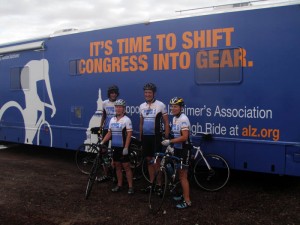 “Cathy and I took the training pretty seriously,” Ryan said. “We started about two months before the run, increasing our mileage significantly, and doing more back-to-back rides. So, instead of doing one long 50-mile ride, we were doing two or three of these in a row.”
“Cathy and I took the training pretty seriously,” Ryan said. “We started about two months before the run, increasing our mileage significantly, and doing more back-to-back rides. So, instead of doing one long 50-mile ride, we were doing two or three of these in a row.”
The Alzheimer’s Association organized the ride, which includes 22 stops. The event is headed for St. Louis this Friday, which lies at about the halfway mark.
Bruce Lamb, a neuroscientist with the Cleveland Clinic in Ohio, and his son, Reza, rode the Holbrook-to-Albuquerque leg with Ryan and Wasmann. Lamb said he came up with the idea for the Breakthrough Ride last summer while cycling.
“I had just returned from reviewing Alzheimer’s disease grants for the National Institutes of Health and was perplexed about the decline in federal funding for Alzheimer’s disease research grants over the past several years. That has resulted in most research laboratories contracting in size and some labs closing all together,” Lamb said. “This was despite the fact that the numbers of Americans dealing with this disease is dramatically increasing, from 5.3 million today to an estimated 16 million by 2050, and will likely eventually bankrupt both Medicare and Medicaid.”
Lamb decided that one way Alzheimer’s researchers might get their message out would be going across the country as a way of engaging everyday Americans. At stops along the way, people are asked to sign petitions asking Congress to ramp up research funding. The goal, Lamb said, is to collect a total of 100,000 signatures. Just over 84,000 have been collected to date.
While everyone thought this was a great idea, Lamb said getting people to sign up for the ride was a challenge.
“We recruited riders however we could: personal contacts, mass e-mails, research websites. You name it, we tried it. For some, like me, it was a professional commitment to the cause. For others, it was the opportunity to challenge themselves in a unique and different way. And for others, it was very personal, as they had family members who have or had the disease.”
Two other Arizonans have been part of the event. Mike Felix from Arizona State University braved the 114-degree heat between Palm Springs, Calif., and Phoenix. Matt Huentelman of the private genetics firm TGen tackled the brutal uphill segment between Phoenix and Holbrook alone.
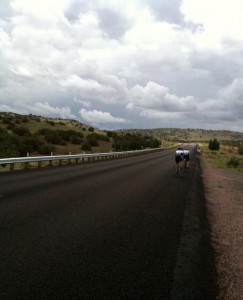
“We never got above 90 degrees because it was overcast the whole time,” Ryan said of her segment. “We rode early to avoid afternoon monsoon storms, but the very first day we got slammed by a thunderstorm and had to pull off the road and get cover. But it was absolutely gorgeous to see large swaths of Arizona that I had never seen before. We saw antelope. We had hawks and falcons flying around us. It was stunningly beautiful.”
Ryan said wherever they went, people were curious about what they were doing and were very supportive. Most shared personal experiences dealing with Alzheimer’s disease.
“It was very striking for me because I do Alzheimer’s research and I know it’s a very common disorder. But you really don’t have a sense of how many people are affected by this disease. I think for all of the people who have ridden so far, it makes it so much more personal and so much more meaningful,” Ryan said.
Several thousand people have added their personal stories on the Alzheimer’s Breakthrough website.
Ryan and the others had a memorable encounter on the third day of the trip. The starting point for the day was a school in Ramah, N.M., near the Continental Divide, where a group of cheering students and teachers showed up with a sign that said “You Can Do It.”
“Before we left, we had a teaching session where I talked to them about the brain and memory, about Alzheimer’s and why we were riding. It was one of the highlights of the ride for me,” she said.
Albuquerque was the end of the line for Wasmann and Ryan. Lamb said he plans to ride a segment from Ann Arbor, Mich., to Cleveland, and the final leg of the trip into Washington. Ryan said also she planned to ride to the Capitol for the finale.
Would Ryan do a ride like this again?
“I don’t think so. I suggested maybe we do it again when somebody finds a cure.”

